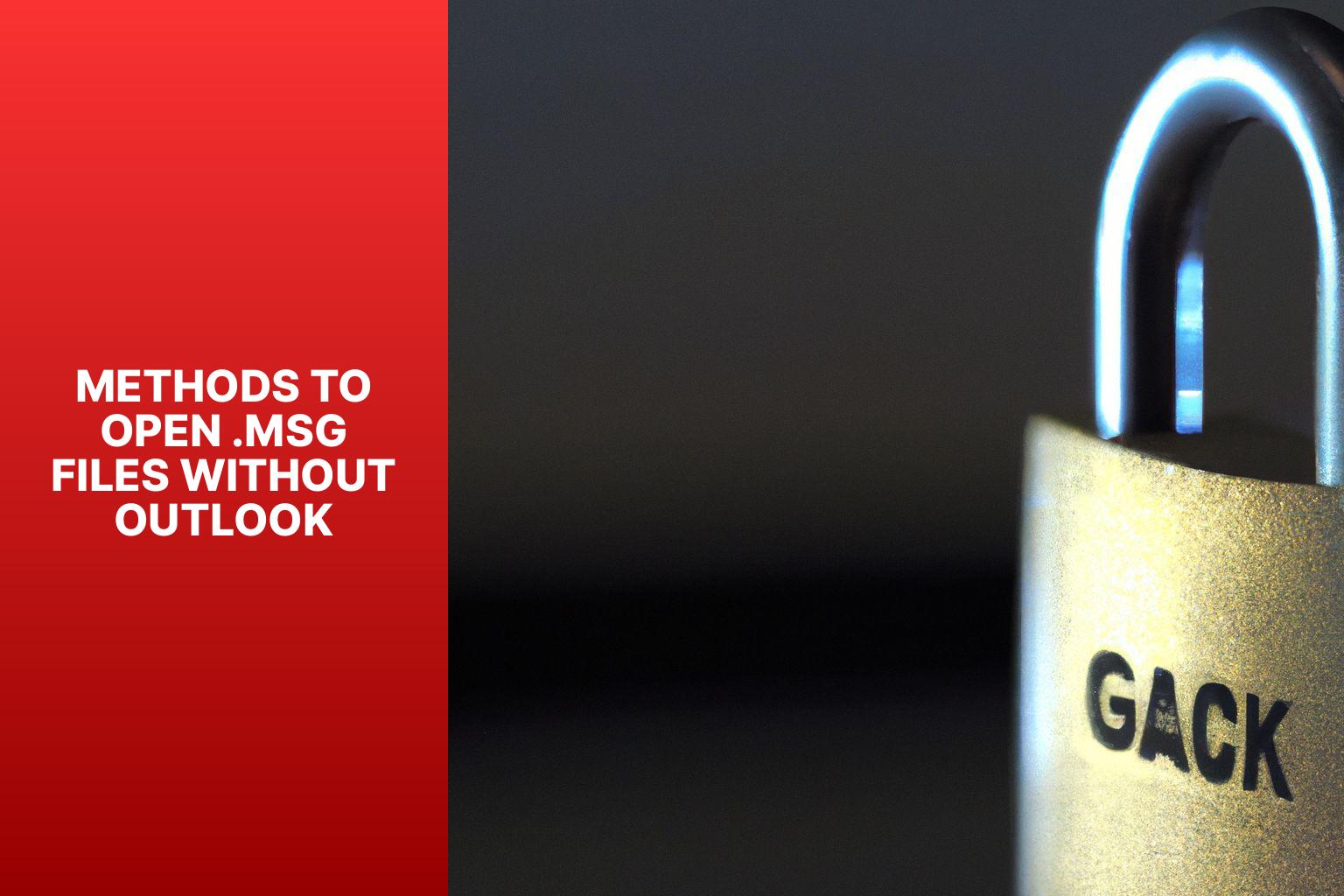How to Open .MSG Files Without Outlook – Quick & Easy Methods
Opening .msg files without Outlook can be a requirement for various reasons such as compatibility issues, cost, and convenience. Not everyone has access to Microsoft Outlook, or they may prefer alternative methods for viewing .msg files. Fortunately, there are several methods available for opening .msg files without Outlook. This article will explore these methods, including using third-party email clients, online .msg file viewers, converting .msg files to other formats, and manual extraction and viewing. It’s essential to consider the limitations and potential security risks associated with these methods. file formatting and the accessibility of attachments and embedded objects may vary when opening .msg files without Outlook. Understanding these considerations will help you choose the most suitable method for your needs.
Key takeaway:
- Compatibility and convenience: Opening .msg files without Outlook provides compatibility with different email clients and offers cost-effective and convenient solutions.
- Alternative methods: There are various methods available to open .msg files without Outlook, such as using third-party email clients, online viewers, converting to other formats, and manual extraction and viewing.
- Considerations: Security risks, file formatting and content preservation, and accessibility of attachments and embedded objects should be taken into account when opening .msg files without Outlook.
Why Would You Want to Open .msg Files Without Outlook?
Why would anyone want to open .msg files without relying on Outlook? Let’s uncover the reasons behind this choice as we explore the compatibility issues and the cost and convenience factors associated with opening .msg files without using the Outlook email client. Buckle up as we dig into the details, presenting you with a compelling case for seeking alternatives to access and manage your .msg files.
Compatibility Issues
Opening .msg files without Outlook can lead to compatibility issues. The .msg file format used by Outlook is not universally supported by all email clients or software applications. Some email clients may not recognize the .msg format and may not be able to display or open the file properly. This can result in the loss or distortion of important email content, such as formatting, attachments, or embedded objects.
To ensure compatibility, it is crucial to use software or email clients that support the .msg file format. Consider the limitations and constraints of your chosen software or email client to avoid issues with loss or distortion of email content.
In the tech industry, compatibility issues have been a concern throughout history. As technology advances, different file formats and software applications are developed, creating a need for compatibility between them. Lack of compatibility can hinder the seamless transfer and access of information. Developers and engineers continue to improve compatibility standards and create solutions for file compatibility across various platforms.
Cost and Convenience
Cost and Convenience of Opening .msg Files Without Outlook
| Method | Cost | Convenience |
|---|---|---|
| Using Third-Party Email Clients | Varies (some are free, others have a cost) | High (easy to use and familiar interface) |
| Online .msg File Viewers | Usually free | Moderate (requires internet connection) |
| Converting .msg Files to Other Formats | Varies (some tools are free, others may require a purchase) | Moderate (additional steps required, but allows for flexibility in file format) |
| Manual Extraction and Viewing | No cost | Low (requires technical knowledge and may result in loss of formatting) |
To open .msg files without Outlook, consider the cost and convenience of different methods.
Using third-party email clients offers high convenience with an easy-to-use interface. The cost varies depending on the client chosen.
Online .msg file viewers are usually free and moderately convenient. They allow you to view the files without additional software, but an internet connection is necessary.
Converting .msg files to other formats allows for flexibility but may have varying costs. This method requires extra steps.
Manual extraction and viewing of .msg files is free but has low convenience. It requires technical knowledge and may result in formatting loss.
The choice of method depends on preferences, budget, and technical expertise. Consider both cost and convenience when deciding how to open .msg files without Outlook.
Methods to Open .msg Files Without Outlook

Photo Credits: Www.Howto-Do.It by Vincent Perez
Looking to open .msg files without the need for Outlook? We’ve got you covered with various methods that provide hassle-free access. In this section, we’ll explore the options at your disposal. From exploring third-party email clients to leveraging online .msg file viewers, converting .msg files to other formats, and even manual extraction and viewing techniques. Stay tuned as we dive into each sub-section, unveiling the ways to unlock your .msg files with ease and convenience.
Using Third-Party Email Clients
Using third-party email clients can open .msg files without Outlook. Here are some benefits and considerations:
1. Compatibility: Third-party email clients handle various file formats, including .msg files, ensuring seamless viewing and accessibility.
2. Additional features: Unlike Outlook, third-party email clients offer customization options and additional features, enhancing email management.
3. User-friendly interface: Many email clients have intuitive interfaces, improving productivity when working with .msg files.
4. Cost-effectiveness: Some email clients are more cost-effective than purchasing an Outlook license, with free versions available.
5. Data privacy and security: Choose a third-party email client with robust privacy and security measures in place to protect sensitive information.
Using third-party email clients provides flexibility and convenience for managing and viewing .msg files outside of Outlook.
Online .msg File Viewers
Online .msg File Viewers allow you to open and view .msg files without Microsoft Outlook. These viewers provide a convenient and cost-effective way to access .msg files. Consider the following key points when using online .msg file viewers:
1. Compatibility: Online .msg file viewers work with different operating systems and web browsers, providing flexibility and accessibility.
2. Convenience: These viewers eliminate the need to install and set up Microsoft Outlook, saving time and resources.
3. Easy file access: Online .msg file viewers allow you to upload .msg files from your computer or cloud storage services, ensuring seamless file retrieval.
4. Advanced functionality: Many online .msg file viewers offer features like searching, sorting, and filtering to help you navigate the content efficiently.
Using online .msg file viewers enhances productivity by providing quick access to .msg files without specific software. It is a convenient solution for individuals who receive .msg files but do not have Outlook installed on their devices.
Fact: Online .msg file viewers are increasingly popular due to their ease of use and compatibility across different platforms.
Converting .msg Files to Other Formats
To convert .msg files to other formats, you can follow these steps:
1. Use email clients: Install third-party email clients like Thunderbird or Windows Live Mail. These clients can open and convert .msg files to formats such as .eml or .pdf.
2. Online converters: Use websites like Zamzar or CoolUtils. These services allow you to upload the .msg file and convert it to formats like .pdf, .eml, or .html.
3. File converters: Utilize software like Total Mail Converter or SysTools MSG Converter. These programs are designed to convert .msg files to formats like .pdf, .eml, .pst, or .html.
4. Manual extraction and conversion: Open the .msg file in a text editor or PST viewer, and copy the content. Then, paste it into a new document or save it as a different file format, such as Microsoft Word (.docx) or plain text (.txt).
By following these methods, you can easily convert .msg files to different formats based on your needs and requirements. Remember, the choice of method depends on your preferences and the availability of the required software or tools.
Manual Extraction and Viewing
- Manually extract and view the .msg file on your computer or storage device.
- Copy the extracted .msg file to a desired location on your computer.
- Search online for a reliable viewer specifically designed for manual extraction and viewing of .msg files.
- Select a reputable online viewer for manual extraction and viewing of .msg files from the search results.
- Upload the extracted .msg file to the chosen online viewer.
- Wait for the viewer to display the contents of the manually extracted .msg file.
- Scroll through the extracted content within the online viewer to view the email message, attachments, and any embedded objects.
- To access and view attachments, simply download and open them on your computer.
- Save any necessary extracted content or attachments that you wish to keep.
- Ensure the security of your computer by deleting both the manually extracted .msg file and any associated content.
Performing the manual extraction and viewing method provides you with an alternative way to access the contents of .msg files, without relying on Outlook. Follow these steps carefully, but keep in mind that this method might not preserve the original file’s formatting and structure. Take precautions regarding security risks when uploading and processing sensitive .msg files online.
Security Risks

Photo Credits: Www.Howto-Do.It by Aaron Perez
When it comes to dealing with .msg files, there are certain security risks that you need to take into consideration:
Malware: It is important to be aware that opening .msg files from unfamiliar or unknown sources can potentially expose your computer to malware or viruses. These threats can compromise the integrity of your data and system.
Phishing Attacks: Cybercriminals often send malicious .msg files disguised as legitimate emails in order to deceive and trick unsuspecting individuals into revealing sensitive information. It is crucial to be cautious and exercise caution when dealing with such files.
Data Leakage: .msg files have the potential to contain confidential and sensitive information, including emails or attachments. This increases the risk of data leaks or breaches of privacy. It is important to handle these files with care.
Exploitation of Vulnerabilities: .msg files can exploit vulnerabilities in software, which may result in unauthorized access to your computer or network. It is essential to stay updated with software patches and security updates to minimize these risks.
Social Engineering: Cybercriminals can utilize .msg files as a means of manipulating users into taking actions that can compromise their security. It is important to remain vigilant and be cautious of any suspicious or unexpected file.
Unauthorized Access to Systems: .msg files may contain hidden scripts or macros that can execute commands, potentially leading to unauthorized access or control by malicious individuals. It is crucial to exercise caution and be mindful of the files you open.
In order to mitigate these security risks, it is essential to exercise caution when dealing with .msg files. Only open files from trusted sources, regularly update your software, and make use of reliable internet security software to scan for potential threats.
File Formatting and Content Preservation
Get ready to learn about the crucial aspects of file formatting and content preservation. We’ll dive into the challenges you may face when dealing with compatibility issues, as well as the cost and convenience factors to consider. Here, you’ll discover valuable insights along with interesting facts and figures that shed light on the importance of opening .msg files without relying on Outlook. So, let’s dig in and explore these essential sub-sections.
Accessibility of Attachments and Embedded Objects
Unlocking the treasures within attachments can be a daunting task, but fear not! In this section, we’ll explore various methods of accessing attachments and embedded objects. From harnessing the power of third-party email clients to utilizing online .msg file viewers, we’ve got you covered. We’ll also touch upon converting .msg files to other formats and the manual extraction and viewing of those elusive attachments. Get ready to conquer the world of attachments and unleash their true potential!
- About the Author
- Latest Posts
Janina is a technical editor at Text-Center.com and loves to write about computer technology and latest trends in information technology. She also works for Biteno.com.

